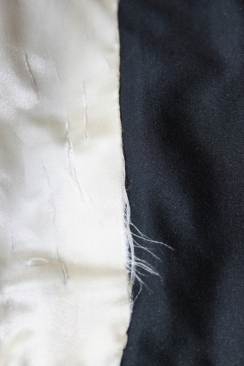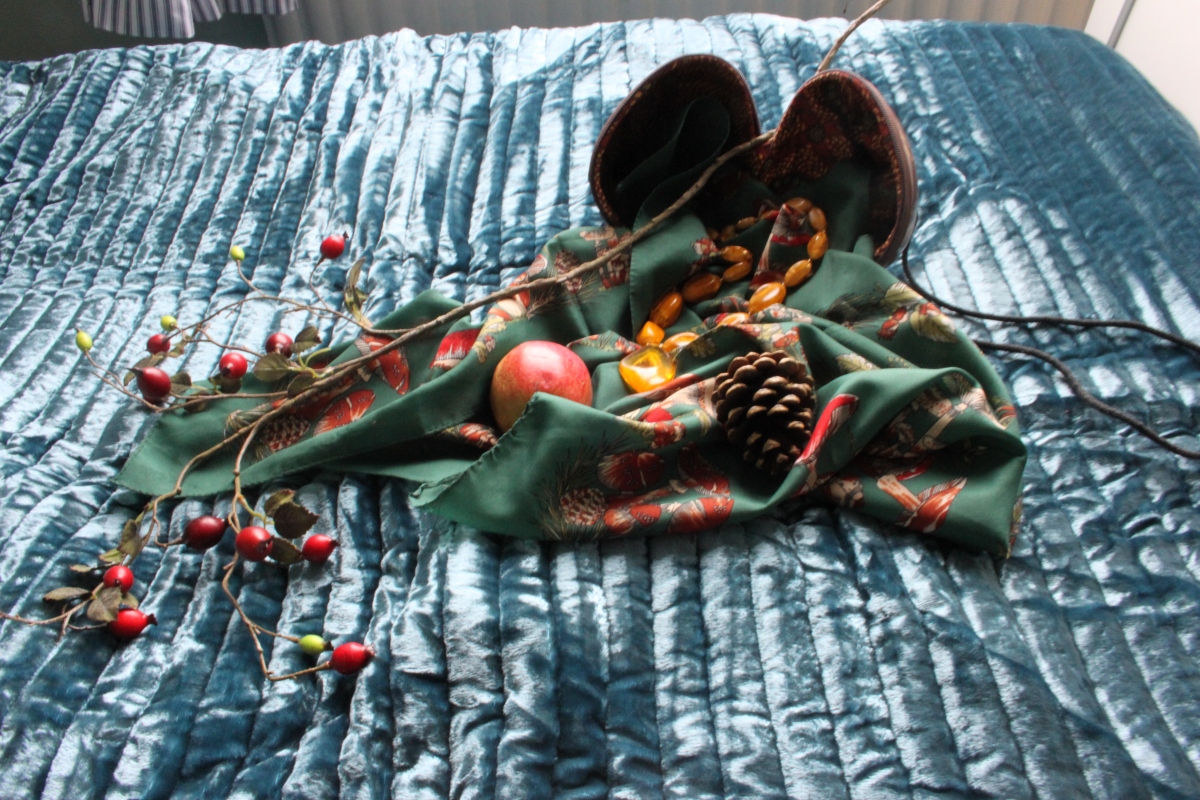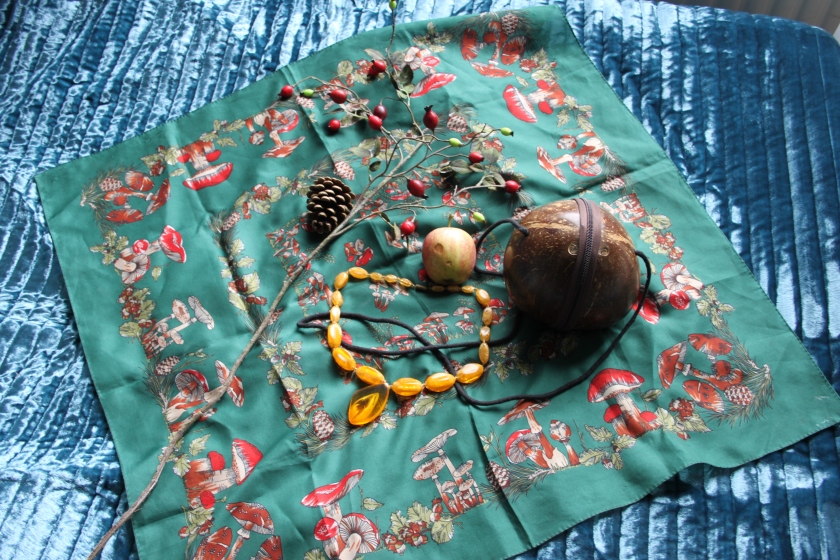
Edwardian jacket
Substance
1. What is the textile made from?
Black silk satin outer, woven silk lining. There is no label to indicate the fibres. I have used observational skills and burn testing to identify the fibres. Silk should be hand washed in mild detergent in lukewarm water. It should be rolled in a towel to remove excess water, then laid flat to dry.
2. What methods have been used in its production?
The fabric is finely woven by machine. The jacket has been constructed using machine and hand-sewing. The collar has been stabilised with hand-stitched interfacing. The jacket has been finished with a lining and machine and hand-finished buttonholes.


3. Where is the textile from?
As silk was produced in Japan, China, India, Italy and the United Kingdom at the time the jacket was supposed to have been made, it is hard to know for sure exactly where it came from. I would make an educated guess that the fabric was produced in the United Kingdom, possibly in Macclesfield.
4. What problems have you encountered in trying to find out this information?
Traceability in textiles is important when considering sustainable and ethical practices. If the supply chain can be traced from producer to consumer, it is possible to know how well a garment complies with’ best practice’, allowing consumers and suppliers to make choices based on their own values and needs.
I am missing information regarding where the fabric and jacket were made and by whom. I could contact the clothing seller where I bought the jacket to see if they have any further information or perhaps a museum to see if they could provide further insights.
Story
1. What other visual indications can you glean from closely examining the textile samples? If the textile has been made into a product, what can you learn from further visual examination?
The jacket is worn in places, with pulled threads and wear on the hem. The silk lining has shattered, probably due to age and wear. Overall, the garment is well-made and still wearable, with robust seams and no obvious holes. I was told by the seller that the jacket is Edwardian. The style, fabrics and construction seem to support this statement. I cannot find any evidence of patina, repair or alterations.



I would guess that the jacket was made by a dress-maker for a middle-class woman, perhaps the wife of a banker or factory owner. Or perhaps it was produced by a dress-maker to wear herself.
2. Are there any elements of the design, detail, decoration or construction of the textile sample that indicate a story behind the textile or product?
I cannot see any specific elements that suggest a story, but it is clear the jacket has been made to last. It was most likely made to a specific person’s measurements, so could be considered personalised in this way.

1950s simulated fur jacket
Substance
1. What is the textile made from?
The fake fur is made from acrylic pile with a woven cotton backing. The lining is labelled as 100% acetate. Both fabrics are machine-made. There is no label, so I have used observation and research to find out what fibres have been used. I could also burn test a small sample of the fibre.

The fabric should be dry-cleaned or can be cleaned at home with gentle hand-washing in mild detergent. It must not be agitated to avoid matting of the pile. It should be dried on a rack and re-positioned often so there are no marks.
2. What methods have been used in its production?
The fabric may have been produced using sliver knitting, which utilises the same machinery as jersey knitting. As this is fabric simulates natural fur, it is likely that it has been heat set to preshrink it. It will probably have been treated with wire brushes to remove loose hairs, known as ‘tigering’. It may also have been ‘electrofyed’ – a polishing technique where the fabric is combed in both directions with heated grooved cylinders. There are no obvious embellishments or treatments to the surface. The fabric has been made up into a jacket, most likely from a dressmaking pattern.
3. Where is the textile from?
There is no label, so it is not possible to know for sure where the fabric or garment was made. The original acrylic fibres would have been synthesised from chemicals in a factory, and it would also have been woven in a factory.
4. What problems have you encountered in trying to find out this information?
It is fairly easy to find out general methods of production for this item, but not the history of this specific item.
Story
1. What other visual indications can you glean from closely examining the textile samples? If the textile has been made into a product, what can you learn from further visual examination?
The jacket is in very good condition, there is no damage and there do not appear to be any alterations or repairs, although it does have a slight musty smell. It seems to have well-looked after, perhaps kept for ‘best’. The style suggests it is from the 1950s, which is also what the original seller told me.
I would guess that it was made by a dressmaker or a skilled home sewer. I imagine it was kept for special occasions or ‘Sunday best’. I wore it myself for a March wedding a few years ago.
2. Are there any elements of the design, detail, decoration or construction of the textile sample that indicate a story behind the textile or product?
Other than presumably being made to fit the original owner, the jacket does not have any specific features that suggest a deeper story. It has been made to last in a classic style.

Rocha.John Rocha chenille coat c.2003
Substance
1. What is the textile made from?
The textile is made from viscose, polyester, cotton and acrylic. The lining is acetate. This information is found on the manufacturer’s label. The fabric should be dry-cleaned, according to the label.

2. What methods have been used in its production?
The fabric has been woven by machine. The pattern has been woven with a chenille fibre to produce a raised area.
3. Where is the textile from?
The label lists the garment as being manufactured in Hong Kong. Given that China is one of the largest producers of textiles in the world today, it is highly likely that the fibres were processed there too.
4. What problems have you encountered in trying to find out this information?
Most of the information about this item is readily available from its label. I could contact the design house for further information.
Story
1. What other visual indications can you glean from closely examining the textile samples? If the textile has been made into a product, what can you learn from further visual examination?
The coat shows areas of wear, with loose buttons and the seam of the lining has split. It has been worn on a regular basis. Overall, it is a sturdy item. I bought the coat new in 2003, so it is about thirteen years old. It has had buttons re-sewn several times.


2. Are there any elements of the design, detail, decoration or construction of the textile sample that indicate a story behind the textile or product?
Although the coat was made for a spring/summer fashion collection for Debenhams, its construction suggests it would last for a long time, perhaps to become a wardrobe staple for its owner. I certainly dig it out every Spring and Autumn.
Nostalgia
It is possible to build stories of the previous wearers of these textiles, but without more specific information it is only a guess based on my existing knowledge and research.
I do feel some nostalgia for all three pieces – the silk and fake fur jackets hark back to times of elegance and glamour, when most women aspired to look well-turned out wherever possible and mostly had clothes made by or for themselves. They were both made a long time before I was born, but wearing them lends a sense of their history to me. The chenille coat is modern and mass-produced, but is building its own story as I wear it.
I didn’t choose these items specifically with nostalgia in mind – it was more that I wanted to represent their visual qualities. Though I didn’t inherit the older coats, they do represent my heritage in a way as they are both handmade. My own mother made or re-fashioned clothes for the family, a skill she learnt from one of her grandmothers and also passed on to me.

 The Objects
The Objects



